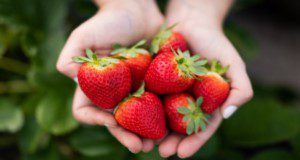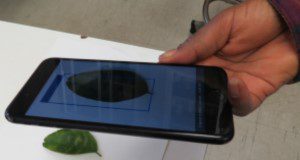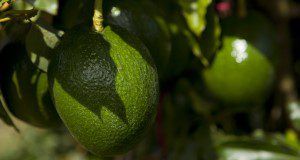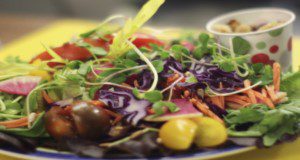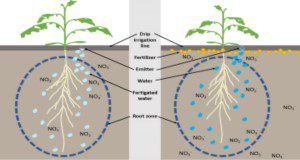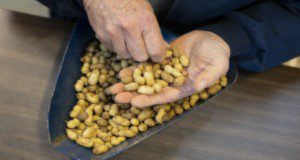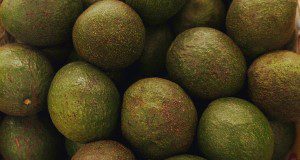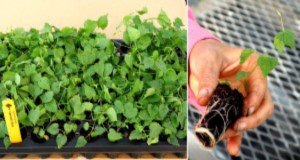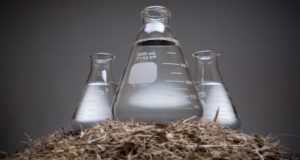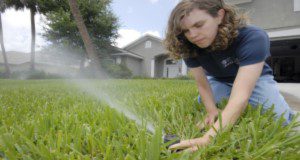Shared-use commercial kitchens are commonly used by food entrepreneurs to launch new food products into market; however, there remain questions about how these facilities work. This new 4-page document defines basic terms used to describe shared-use commercial kitchens, such as incubator, accelerator, or food hub, and gives an overview of potential services or resources available at these facilities. Furthermore, basic information on state level food regulations and an extensive list of shared-use commercial kitchens in Florida is included. Written by Matthew Krug and Sarah Ellis and published by the UF/IFAS Food Science and Human Nutrition Department.
https://edis.ifas.ufl.edu/fs400
Author: Paul Roberts
Pestalotia Leaf Spot and Fruit Rot of Strawberry
Pestalotiopsis-like fungi cause diseases on many different species of plants worldwide, including strawberry. The pathogen is not necessarily new to strawberry and was first reported causing fruit rot in Florida and Israel in the 1970s. However, during the 2018–19 and 2019–20 strawberry seasons, severe and unprecedented outbreaks were reported in Florida, characterized by symptoms on nearly all plant parts including roots, crowns, petioles, fruit, and leaves. This new 4-page publication of the UF/IFAS Plant Pathology Department describes the disease and its causal agent and briefly covers what is known about disease development and control practices. This document will provide valuable information to strawberry nursery and fruit production growers. Written by Juliana S. Baggio and Natalia A. Peres.
https://edis.ifas.ufl.edu/pp357
Computer Tools for Diagnosing Citrus Leaf Symptoms (Part 2): Smartphone Apps for Expert Diagnosis of Citrus Leaf Symptoms
Visual identification of nutrient deficiencies in foliage is an important diagnostic tool for fine-tuning nutrient management of citrus. This new 2-page article describes a new smartphone app that uses a trained neural network to identify disease and pest symptoms on citrus leaves through your phone’s camera. Written by Arnold Schumann, Laura Waldo, Perseveranca Mungofa, and Chris Oswalt, and published by the UF/IFAS Department of Soil and Water Sciences.
https://edis.ifas.ufl.edu/ss691
Fusarium Wilt: A New Threat to Florida Lettuce Production
Fusarium wilt of lettuce is a disease caused by the fungus Fusarium oxysporum f.sp. lactucae. The disease is present in all lettuce production areas worldwide. Recently this disease has been identified in Florida in localized fields. This new 4-page publication of the UF/IFAS Horticultural Sciences Department presents information about the disease, symptoms, and control measures useful to lettuce growers in Florida. Following these recommendations may help to avoid the spread of this fungus in muck soils at the Everglades Agricultural Area (EAA), where 90% of the lettuce in Florida is planted. Written by Germán V. Sandoya, Jesse J. Murray, Richard N. Raid, and Christian F. Miller.
https://edis.ifas.ufl.edu/hs1385
Recomendaciones para la Detección y Mitigación de la Marchitez del Laurel en Árboles de Aguacates y Especies Relacionadas en Jardines y Patios Hogareños
This is the Spanish translation of HS1358, Recommendations for the Detection and Mitigation of Laurel Wilt Disease in Avocado and Related Tree Species in the Home Landscape. Avocado trees are a popular choice for homeowners in Florida, with over 600,000 growing in Florida home landscapes. However, avocado trees as well as others in the Lauraceae family are susceptible to laurel wilt disease, which can kill a tree in as few as three weeks. This new 8-page publication of the UF/IFAS Horticultural Sciences Department provides home owners recommendations for identifying and mitigating laurel wilt disease in the home landscape. Written by Jonathan H. Crane, Jeff Wasielewski, Daniel Carrillo, Romina Gazis, Bruce Schaffer, Fredy Ballen, and Edwards Evans.
https://edis.ifas.ufl.edu/hs1384
Popular Diets: Intermittent Fasting
Weight loss can be challenging. Starting a restrictive diet can be emotionally draining and difficult to adhere to. Is there a more effective way to lose weight? Does the timing and frequency of meals help to lose weight? This new 4-page publication of the UF/IFAS Food Science and Human Nutrition Department describes the benefits and risks of intermittent fasting for weight loss. Written by Michelle Yavelow, Daniela Rivero Mendoza, and Wendy Dahl.
https://edis.ifas.ufl.edu/fs409
Dieta e inflamación crónica
La inflamación es la respuesta de su cuerpo a las lesiones e infecciones—así es como su sistema inmunológico ayuda a protegerlo de cualquier daño. Por el contrario, la inflamación crónica contribuye a muchas enfermedades, como enfermedades cardíacas, diabetes y enfermedades renales y hepáticas. Esta publicación discute la inflamación y las opciones alimentarias que pueden ayudar a reducir la inflamación crónica.
This is the Spanish translation of FSHN20-43, Diet and Chronic Inflammation. Written by Daniela Rivero-Mendoza and Wendy Dahl, translated by Daniela Rivero-Mendoza, and published by the UF/IFAS Food Science and Human Nutrition Department.
https://edis.ifas.ufl.edu/fs405
How to Measure Leaf Disease Damage Using Image Analysis in ImageJ
This new 13-page article introduces simple image processing and analysis techniques to quantify leaf disease damage using ImageJ, an open-source image processing program. These techniques are not meant to replace crop scouting or disease diagnosis by a plant diagnostic laboratory, but rather to provide a supplemental tool for making quantitative measurements of leaf disease damage. Similar techniques are also available for plant growth assessment, including plant height, plant width, and canopy cover area. The image processing and analysis techniques introduced in this article are fairly simple to use and thus can be adopted not only by researchers, but also by producers, crop consultants, Extension agents, and students. Written by Lillian Pride, Gary Vallad, and Shinsuke Agehara, and published by the UF/IFAS Horticultural Sciences Department.
https://edis.ifas.ufl.edu/hs1382
Implementing the Five Rs of Nutrient Stewardship for Fertigation in Florida’s Vegetable Production
The five Rs of nutrient stewardship is a mnemonic device used to emphasize accuracy and precision for nutrient management so as to apply the (1) right source of fertilizer at the (2) right rate at the (3) right time in the (4) right place with the (5) right irrigation. Because the majority of Florida’s soils are sandy, this fifth R is imperative for sustainable nutrient management for commercial crop production. These main points of nutrient management (source, rate, time, place, irrigation) may help enhance sustainability by reducing pollution by eutrophication, nitrogen loss through ammonia volatilization, and climate change from soil greenhouse gas emission. This new 8-page publication of the UF/IFAS Horticultural Sciences Department was written by Mary Dixon and Guodong Liu.
https://edis.ifas.ufl.edu/hs1386
Diet and Chronic Inflammation
Inflammation is your body’s response to injury and infection—it’s how your immune system helps to protect you from harm. In contrast, chronic inflammation contributes to many diseases, including heart disease, diabetes, and kidney and liver disease. This new 4-page publication of the UF/IFAS Food Science and Human Nutrition Department discusses inflammation and the dietary choices that may help to reduce chronic inflammation. Written by Daniela Rivero-Mendoza and Wendy Dahl.
https://edis.ifas.ufl.edu/fs402
Weight Loss and the Older Adult: Risks and Benefits
Adults who are obese are often advised to lose weight to reduce the risk of chronic disease. However, the health benefits of weight loss change as we become older, and unintentional weight loss is linked to its own set of health risks. This new 3-page publication of the UF/IFAS Food Science and Human Nutrition Department discusses the risks and benefits of planned and unplanned weight loss for older adults. Written by Wendy Gans, Rachelle Savelle, Nancy J. Gal, and Wendy Dahl.
https://edis.ifas.ufl.edu/fs401
Popular Diets: Raw Foods
The raw foods diet has its roots in a vegetarian movement dating back to the 1800s. As the name implies, a raw foods diet is a dietary pattern composed of mostly or completely raw, unprocessed foods. This new 3-page publication of the UF/IFAS Food Science and Human Nutrition Department explores the potential health benefits and risks of a raw foods diet. Written by Alexa Barad, Daniela Rivero-Mendoza, and Wendy Dahl.
https://edis.ifas.ufl.edu/fs404
Popular Diets: Ketogenic Diet
The ketogenic diet is a high-fat, very low carbohydrate diet. The first documented use of the ketogenic diet was in 1921 to treat epilepsy in children. In the past few years, the ketogenic diet has resurged in popularity as a potential means for weight loss. The ketogenic diet has become popular due to celebrity endorsement and social media influences. This new 4-page publication of the UF/IFAS Food Science and Human Nutrition Department explains the concepts behind this diet, explores the available menu, and examines whether this diet is safe and effective. Written by Kelsey Gemmill, Daniela Rivero-Mendoza, and Wendy Dahl.
https://edis.ifas.ufl.edu/fs403
Production Guide for Choy Sum: An Emerging Asian Vegetable in Florida
Choy sum, also known as Chinese flowering cabbage, is a leafy vegetable that has been widely cultivated in southern China for more than 1,000 years, and is currently cultivated and consumed by a growing population in the western world. This new 5-page publication of the UF/IFAS Horticultural Sciences Department, written by Yanlin Wang and Guodong Liu, provides a brief overview of choy sum and its cultivation, as well as some suggestions for how to include it in a meal.
https://edis.ifas.ufl.edu/hs1380
Wastewater and Septic System Management for the COVID-19 Virus: Frequently Asked Questions
This new 3-page publication of the UF/IFAS Department of Soil and Water Sciences answers common questions about the potential role of wastewater and septic systems in transmission of COVID-19. It is intended as guidance for the general public. Written by Mary G. Lusk.
https://edis.ifas.ufl.edu/ss692
Recomendaciones para el Control y Mitigación de la Marchitez del Laurel y sus Vectores, los Escarabajos Ambrosia, en Arboledas Comerciales de Aguacate en Florida
This is the Spanish translation of Recommendations for Control and Mitigation of Laurel Wilt and Ambrosia Beetle Vectors in Commercial Avocado Groves in Florida (HS1360). Laurel wilt and the ambrosia beetle vectors that transmit this lethal disease have and will continue to affect avocado production in Florida. At least 50% of the commercial producers are Hispanic Americans and some are more comfortable with publications in Spanish. The translator, Rubén Regalado, and reviewer, Carlos Balerdi, are both previous employees of UF/IFAS.
https://edis.ifas.ufl.edu/hs1379
Irrigation System Descriptions for Tropical and Subtropical Fruit Crops in Florida
Florida’s tropical and subtropical fruit crop industries use various irrigation systems, including high-volume systems designed for irrigation and freeze protection, drip systems for herbaceous fruit crops (papaya, banana), and microsprinkler types, mainly for irrigation and fertigation. There continues to be a steady stream of potential tropical and subtropical fruit producers in Florida, many with little to no knowledge of the various types or purposes of various irrigation system that have been used successfully for the past 60 years. This new 9-page publication of the UF/IFAS Horticultural Sciences Department includes potential producers, Extension faculty and agents, and irrigation companies. Written by Jonathan Crane, Haimanote Bayabil, Edward A. Evans, and Fredy Ballen.
https://edis.ifas.ufl.edu/hs1375
Selection and Preparation of Planting Material for Successful Hop Production in Florida
Hops (Humulus lupulus L.), an essential ingredient in beer, have potential to develop as a viable alternative crop in Florida. In our surveys, many breweries have expressed strong interest in using locally grown hops. However, hop production is plagued by many diseases, most of which were inadvertently introduced through the movement of contaminated planting material. The primary purposes of this new 7-page article are to prevent the introduction of these diseases into the state and to provide recommendations for selecting and preparing planting material for successful hop production in Florida. This publication of the UF/IFAS Horticultural Sciences Department is part of a larger series that will review the challenges of hop production, based on research experience at the UF/IFAS Gulf Coast Research and Education Center (UF/IFAS GCREC) in Balm, FL.
https://edis.ifas.ufl.edu/hs1381
Biofuel: Concepts and Considerations
Biofuels are combustible fuels derived from recently produced biomass, as opposed to ancient biomass, which is the source of petroleum products. The term biofuel usually refers to liquid fuels used as replacements for or additives to petroleum-based liquid fuel. This new 6-page publication of the UF/IFAS Department of Soil and Water Sciences serves as an introduction to biofuels for Extension educators and anyone interested in learning basic terminology, concepts, and impacts of biofuels as a replacement for fossil fuels. Written by Tanumoy Bera, Kanika S. Inglett, and Ann C. Wilkie.
https://edis.ifas.ufl.edu/ss688
Best Practices for Communicating about Outdoor Residential Water Conservation
Extension communication efforts can be made more effective when following a strategic communication plan. To guide a strategic communication effort, it is imperative to have purposeful messaging along with an understanding of your target audience and communication channel. This new 3-page document, published by the UF/IFAS Department of Agricultural Education and Communication, presents a synthesis of literature highlighting best communication practices in regard to water conservation efforts. Written by Jacqueline Aenlle and Laura A. Sanagorski Warner.
https://edis.ifas.ufl.edu/wc366

